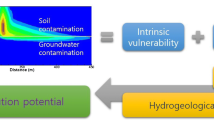Abstract.
The evaluation of the contaminant transport is dictated by the Federal Soil Protection Regulation (BBodSchV, 1999) for sites that are suspected to endanger the groundwater. A prognosis for contaminant transport by infiltrated water must therefore be carried out. Within the framework of a research project supported by the BMBF (Federal Ministry for Education and Research), a new investigation concept for the prediction of contamination input into the groundwater was developed.
This concept considers the estimation of the emission (E) of the contaminants i.e. the amount and concentration of the leachate of the contamination source in correlation with the time. The amount of leachate can be estimated by the infiltration of the groundwater recharge for every hydrological year using hydrological parameters. The expected concentration can be obtained from elution tests. In a second step, the transmission (T) i.e. the pollutant transport through the unsaturated zone into the groundwater is evaluated. This evaluation considers the transport mechanisms advection, diffusion and the retardation potential of the transmission zone. As a result, the immission (I) into the groundwater, the amount and concentration of the contaminants input can be estimated. Finally, it is important to evaluate the sensitivity of the system by classifying the groundwater according to the source value. This evaluation technique comprises the characterization of the site and the estimation of the contamination potential by conducting laboratory and in-situ tests and numerical simulation modelling involving iteration for a contaminant mass balance.
In this paper, a new testing method for the determination of the characteristic parameters for the transport mechanisms including the retardation potential is described. This method is carried out in a diffusion cell. An evaluation concept for the contaminant transport based on the testing results is presented and discussed.
Access this chapter
Tax calculation will be finalised at checkout
Purchases are for personal use only
Preview
Unable to display preview. Download preview PDF.
Similar content being viewed by others
Author information
Authors and Affiliations
Corresponding author
Editor information
Rights and permissions
About this chapter
Cite this chapter
Azzam, R., Lambarki, M. Evaluation Concept and Testing Method for Heavy Metal Contaminant Transport in the Underground. In: Hack, R., Azzam, R., Charlier, R. (eds) Engineering Geology for Infrastructure Planning in Europe. Lecture Notes in Earth Sciences, vol 104. Springer, Berlin, Heidelberg. https://doi.org/10.1007/978-3-540-39918-6_15
Download citation
DOI: https://doi.org/10.1007/978-3-540-39918-6_15
Published:
Publisher Name: Springer, Berlin, Heidelberg
Print ISBN: 978-3-540-21075-7
Online ISBN: 978-3-540-39918-6
eBook Packages: Springer Book Archive




